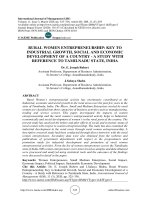Economic growth and economic development 398
Bạn đang xem bản rút gọn của tài liệu. Xem và tải ngay bản đầy đủ của tài liệu tại đây (142.43 KB, 1 trang )
Introduction to Modern Economic Growth
the previous section. However, we do not need to appeal to these theorems since in
this together case it is straightforward to show the equivalence of the two problems.
To do this, let us once again set up the current-value Hamiltonian, which in this
case takes the form
ˆ (k, c, µ) = u (c (t)) + µ (t) [f (k (t)) − (n + δ)k (t) − c (t)] ,
H
with state variable k, control variable c and current-value costate variable µ. As
noted in the previous chapter, in the relevant range for the capital stock, this problem satisfies all the assumptions of Theorem 7.14. Consequently, the necessary
conditions for an optimal path are:
ˆ c (k, c, µ) = 0 = u0 (c (t)) − µ (t) ,
H
ˆ k (k, c, µ) = −µ˙ (t) + (ρ − n) µ (t) = µ (t) (f 0 (k (t)) − δ − n) ,
H
lim [exp (− (ρ − n) t) µ (t) k (t)] = 0.
t→∞
Repeatingthe same steps as before, it is straightforward to see that these optimality
conditions imply
c˙ (t)
1
=
(f 0 (k (t)) − δ − ρ) ,
c (t)
εu (c (t))
which is identical to (8.20), and the transversality condition
à Z t
ảá
0
(f (k (s)) − δ − n) ds
= 0,
lim k (t) exp −
t→∞
0
which is, in turn, identical to (8.11).
This establishes that the competitive equilibrium is a Pareto optimum and that
the Pareto allocation can be decentralized as a competitive equilibrium. This result
is stated in the next proposition:
Proposition 8.1. In the neoclassical growth model described above, with Assumptions 1, 2, 3 and 4’, the equilibrium is Pareto optimal and coincides with the
optimal growth path maximizing the utility of the representative household.
8.4. Steady-State Equilibrium
Now let us characterize the steady-state equilibrium and optimal allocations. A
steady-state equilibrium is defined as in Chapter 2 as an equilibrium path in which
384









